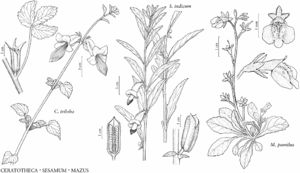Herbs [shrubs or trees], annual [perennial], not fleshy [± fleshy], autotrophic, stipitate-glandular, hairs mucilaginous. Stems erect or arching [prostrate]. Leaves cauline, opposite, rarely alternate distally, simple, 3-lobed, or 3-foliolate [digitate]; stipules absent; petiole present; blade not fleshy [± fleshy], not leathery, margins entire, toothed, or lobed. Inflorescences terminal, racemes or axillary, flowers solitary; bracts present. Flowers bisexual, perianth and androecium hypogynous; sepals 5, proximally connate, calyx ± bilaterally symmetric; petals 5, connate, corolla bilaterally symmetric, bilabiate [lobes subequal], funnelform; stamens 4, adnate to corolla base, didynamous, glabrous, filaments glabrous; staminode 0 or 1; pistil 1, 2-carpellate, ovary superior, 2-locular or 4-locular, often with false septa proximally, especially in fruit, placentation axile; ovules anatropous, unitegmic, tenuinucellate; style 1; stigma 1, 2-lobed, lobes spreading, filiform. Fruits capsules, dehiscence loculicidal, sometimes incomplete, with or without 2, subapical horns. Seeds [10–] 30–60, white, brown, or black, obovoid to pyriform or ovoid; embryo straight, endosperm sparse.
Distribution
Introduced; s Asia, Africa, Australia, also in South America, Europe, elsewhere in Asia, n Africa, Pacific Islands
Discussion
Genera ca. 13, species ca. 79 (2 genera, 2 species in the flora).
Often combined with the chiefly New World Martyniaceae, Pedaliaceae are an Old World family distinguished by mucilaginous hairs, nectaries on the pedicels, axile placentation, colpate pollen, and fruits without an enlarged, woody endocarp (H.-D. Ihlenfeldt 1967, 2004). Pedaliaceae appear to be most closely related to members of Acanthaceae and Bignoniaceae. Molecular study supports results of morphological studies (R. G. Olmstead et al. 2001) and indicates that Martyniaceae and Pedaliaceae are nested in different clades.
The center of diversity of Pedaliaceae is sub-Saharan Africa, where all but one genus are native. Both genera introduced to the flora area belong to Sesameae (Endlicher) Meisner, one of three tribes recognized (H.-D. Ihlenfeldt 2004).
Selected References
Lower Taxa
Illustrations
| Family ⠉ | Plate of taxon | Illustrator ⠉ | |
|---|---|---|---|
 | Mazaceae Pedaliaceae Pedaliaceae | Mazus pumilus Ceratotheca triloba Sesamum indicum | John Myers Barbara Alongi Barbara Alongi |
Key
| 1 | Capsules with 2, subapical horns; plants foul smelling; staminodes 0 (or 1). | Ceratotheca |
| 1 | Capsules without horns; plants not foul smelling; staminodes. | Sesamum |